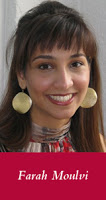PRIM&R is pleased to share a piece from the PRIM&R Blog Squad at the 2012 Institutional Animal Care and Use Committee (IACUC) Conference. The Blog Squad is composed of PRIM&R members who are devoted to blogging live from our conferences. This is Farah Moulvi’s second year serving as a member of the PRIM&R Blog Squad.
IACUC administrators involved with wildlife research are familiar with the diversity of wild animals and the unique scenarios that arise when reviewing research proposals involving wildlife.
Wildlife research includes animals living in their natural habitats as well as those captured from the wild. Although general welfare principles apply to wildlife studies, the traditional approaches and procedures for laboratory-bred animals may not be appropriate.
Wildlife studies often differ from biomedical research, as the objectives usually relate to understanding the species’ behavior, ecology, or disease, rather than human benefit.
Robert Sikes, one of three presenters in Wildlife Protocol Oversight, Including Special Challenges When Conducting Field Studies at the 2012 IACUC Conference, mentioned that the diversity of wildlife animals is made up of around 52,000 species, and that procedures used in field studies vary according to the taxa and environment. Considering that the Guide for the Care and Use of Laboratory Animals provides only four paragraphs on wildlife research and that this guidance applies only to the use of vertebrates covered by Public Health Service (PHS) assurances in PHS-funded research, this resource may not be specific enough for the diversity of wildlife represented.
There are guides put out by several professional societies’ that serve to supplement the information contained within the Guide . The presenters mentioned several examples, such as the American Society of Mammalogists, the American Society of Ichthyologists and Herpetologists, the Ornithological Council, and the American Fisheries Society. The guidelines of these four groups serve as references for best practices for both principal investigators (PIs) and IACUC members. They also contain useful information relating to wildlife-specific items, such as the capture and marking of natural populations , occupational health concerns, personal protective equipment usage, and the inspection and monitoring for these studies.
This session also emphasized the need for IACUCs to balance the welfare of wild animals with the unique model required for this type of research. Speakers mentioned several factors such as the locale of the research (e.g. the terrain, altitude), the climate, whether site visits are feasible, and how recordkeeping of audio and visual documentation is accomplished.
Jon Geller discussed unexpected outcomes associated with capturing and marking animals. He suggested that IACUCs consider asking PIs to provide a description of unexpected outcomes. For example, a PI may want to provide information on the potential of an adverse event occurring during the capture and restraint process.
The presenters suggested that when reviewing wildlife protocols IACUCs also consider the risk to the indigenous population of a habitat, the impact on captive animals if released, and how would animals would interact with other species. A PI should anticipate any collateral or opportunistic captures, and estimate what the effect and disposition of the animal would be. Other circumstances IACUCs face when reviewing field studies include pain and distress categories, and mortality rates during capture and release.
Another topic of discussion was how the IACUC ensures that the value of such research is worth the use of the animals involved and how the knowledge gained from the research can be applied to the population being studied. Statistical methods cannot always be used to determine the number of free-ranging animals needed in experimental groups. Sometimes the IACUC may have to take the type of animal being used into consideration (e.g. dolphins and elks are very different from mice and rats). Although a mathematical formula for determining the research population may be needed for valid results, practical considerations must be applied when using free-ranging wildlife. These statistical questions are answered differently when using smaller animals in high densities, rather than rare, endangered, or threatened species.
With such diverse issues, an IACUC that reviews wildlife protocols must have a field researcher and/or field biologist serving on the committee. Ad hocs and/or society representatives should also be utilized for consultation as needed.
The take-home message from this session was that one size does not fit all. Because of the diversity of issues IACUCs and researchers face, they must learn to work together to comply with the law and protect the privilege of using free-ranging animals in research. Welcome to the world of the IACUC’s wild side!


Thank you for your excellent overview. I appreciate your insight on this subject. Your article provides us some insight into the lack of information pertaining to Wildlife within the Guide. The presenters suggestions for supplemental information should prove to be of great value.
Thank you for reading and responding. If you found this piece interesting, you may want to consider reading the Guidelines of the American Society of Mammalogists for the Use of Wild Mammals in Research. You can check it out here: http://bit.ly/gwQOE2